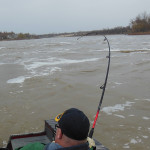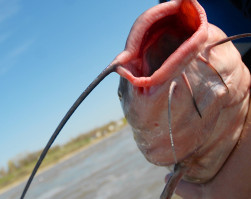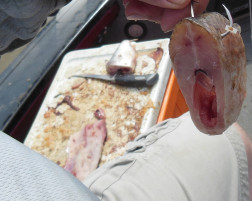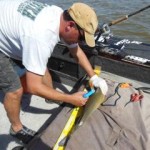Channel Catfish
The Channel Catfish
The first thing to understand about our channel catfish is that they  are not the slow, sluggish, bottom dwelling, garbage eaters that many think they are. In fact they are one of the most well adapted, highly evolved predator fish swimming in fresh water. They have high tolerances for pollution and low oxygen levels. They exists and do well in waters dominated by other fish and thrive in waters not well suited for some of the other popular game fish . In laboratory experiments the channel catfish always finish at the top of the class for memory and intelligence tests, far above walleye, bass and trout.
are not the slow, sluggish, bottom dwelling, garbage eaters that many think they are. In fact they are one of the most well adapted, highly evolved predator fish swimming in fresh water. They have high tolerances for pollution and low oxygen levels. They exists and do well in waters dominated by other fish and thrive in waters not well suited for some of the other popular game fish . In laboratory experiments the channel catfish always finish at the top of the class for memory and intelligence tests, far above walleye, bass and trout.
 Catfish have an incredible sense of smell and taste. With millions of scent receptors all over their body they can taste bait just by rubbing up against it. Their whiskers are super scent receptors and only have to be near bait to sense or smell it. Simply swimming over bait is enough to identify it as something they might want. This is why scent is key when fishing for channels catfish. Remember that, “scent is key” but also understand that does not mean you need to use the most foul smelling pungent stink bait you can find. What that means is when you find a bait that is working well for cats and they are really keying in on it …make it juicy! The more your bait is dripping from its natural oils and fluid, the more saturated in that flavor you can make it the better it will work. For instance if you are fishing for spring cats and cut sucker is working then dipping your bait, line, and weight in sucker blood, sucker eggs and guts, so it is dripping from “sucker juice” when you toss it in the better it will likely work. Refreshing you bait every 15 to 20 minutes and keeping those juices fresh and strong will only increase you catches. Fresh bait is best, fresh frozen almost as good. Old refrozen mushy bait is only good for the trash or for chum and far less effective.
Catfish have an incredible sense of smell and taste. With millions of scent receptors all over their body they can taste bait just by rubbing up against it. Their whiskers are super scent receptors and only have to be near bait to sense or smell it. Simply swimming over bait is enough to identify it as something they might want. This is why scent is key when fishing for channels catfish. Remember that, “scent is key” but also understand that does not mean you need to use the most foul smelling pungent stink bait you can find. What that means is when you find a bait that is working well for cats and they are really keying in on it …make it juicy! The more your bait is dripping from its natural oils and fluid, the more saturated in that flavor you can make it the better it will work. For instance if you are fishing for spring cats and cut sucker is working then dipping your bait, line, and weight in sucker blood, sucker eggs and guts, so it is dripping from “sucker juice” when you toss it in the better it will likely work. Refreshing you bait every 15 to 20 minutes and keeping those juices fresh and strong will only increase you catches. Fresh bait is best, fresh frozen almost as good. Old refrozen mushy bait is only good for the trash or for chum and far less effective.
Many anglers make the assumption that because catfish have a heightened sense of scent reception  they don’t see well or hear/feel vibrations as well. Catfish actually have excellent eyesight and can feel vibrations and “noise” in the water as well as any fish if not better. This is why at times you can catch cats on lures, twister tails and by floating baits through fast current areas. I have even seen cats beach themselves chasing baits onto the bank. You often see channel cats busting goldeye near the surface. Cats will adapt to whatever conditions are present and because of the abundance of food choices available to them in the Red River they will key in on whatever bait they prefer at the time and hunt it in whichever way they need to.
they don’t see well or hear/feel vibrations as well. Catfish actually have excellent eyesight and can feel vibrations and “noise” in the water as well as any fish if not better. This is why at times you can catch cats on lures, twister tails and by floating baits through fast current areas. I have even seen cats beach themselves chasing baits onto the bank. You often see channel cats busting goldeye near the surface. Cats will adapt to whatever conditions are present and because of the abundance of food choices available to them in the Red River they will key in on whatever bait they prefer at the time and hunt it in whichever way they need to.
The channel catfish is the true king of the Red River!
Red River Catfish Tagging Study *UPDATE – APRIL 28 2015
As far as population size, we are looking at somewhere in the neighborhood of 350,000 channel catfish from Lockport to the Sugar Island/Bridge to Nowhere area. This is where the confidence intervals make things a bit hairy because the range is essentially from 10,000 to 1,000,000 meaning that our true population estimate could fall somewhere in that range. The more tag returns we get, the more we can ratchet those confidence intervals down to get a more precise estimate.
Since Late 2012 fisheries biologist Mark Pegg of the University of Nebraska along with colleagues, students, and the help of Manitoba fisheries and local fisheries biologist Derek Kroeker, have been operating a catfish tagging study on the Red River in Manitoba in order to do research on our world famous channel catfish. With a combination of hoop nets and sport angling the researchers have over 3100 catfish tagged to date. The purpose of this study is to get a better understanding of our channel catfish, their behavior, and the system they live in. The catfish are tagged with a thin orange tag just behind the cats dorsal fin (the fin on the top of it’s back). On the tag is a phone number and a tag number. If you catch a tagged catfish please record the tag number and phone the catfish hotline listed on the tag and report where it was caught, when it was caught, and it’s size. This information is vital to the study. The catfish hotline is: 1-855-207-7706.
I got to spend a day in the boat with both Derek Kroeker and Mark Pegg last year and got to take part in tagging around 40+ cats that day. I can tell you first hand what a wealth of information these guys are and how passionate they are about this study. So far, in addition to the local recaptures they have had long distance recaptures from as far away as Drayton south of the border, as well as from the Sheyenne River near Fargo. Locally we have had recaps come back from the Assiniboine River as well as Grand Maria north on Lake Winnipeg.
I wrote an article about my day with the biologists and did an interview with Mark to see what they have found so far. You can read the whole article and interview with mark here. Facts On Cats.


